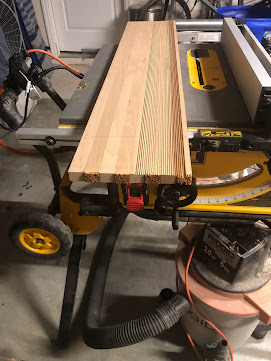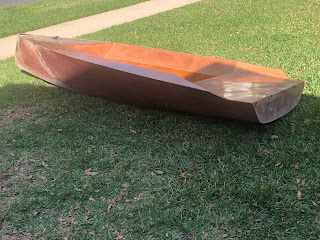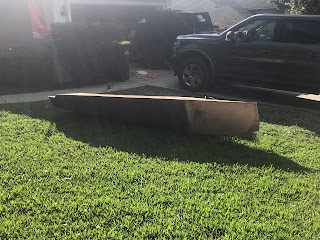Between sanding and rigging the boat for the first time, there was lots to do before heading to the race course on day one of the Classic Moth Midwinters. I didn't take many pictures, but I here's the one I did take with the port hole cover getting installed along with a wood pillar to mount the mainsheet block to.
I had a plan for things like the vang, the cunningham, the mast puller, and the traveler controls, but none of these things were proven. The mechanics of sailing was of little consequence if the design deviation from the mistral and the Mousetrap (mod Mistral) was not successful though. Quick recap on some of those differences:
- Significant reduction of wetted surface forward. The bow is much more narrow and the beam is intentionally shy of max.
- Intentionally reversed bow. I added the reversed bow to reduced volume forward.
- Shape at each station was pushed down towards the waterline so that max camber was closer to the centerline of the vessel. The result was flatter gunwales and slightly more volume below the waterline forward compared to the Mistral
- Flattened transom with a fair transition into the corners.
A rite of passage for a new boat is the all-important class measurement. The length was on the money, the width was under as expected, but the weight was REALLY close. The balancing act to put a boat on bathroom scale is interesting to begin with. Any little move and the number shifted. After multiple attempts to get a stable number we finally got the scale to read a constant 75.0 lbs. The class minimum is 75.0 lbs. The one issue that came out of measurement was my sail. Unfortunately the sail came with a bolt rope on it when I ordered a loose footed sail. I seam ripped off the bolt rope, but there was still too much foot shelf to measure in. To be legal, I had to lace the sail to my boom with sail ties. It wasn't pretty, but it got me on the race course.
Setting up before the race on Saturday
With all the rush to get the boat completed I didn't do a great job of documenting some of the details, but I had a fun time making carbon fiber fixtures for the boat. These include the vang attachment to the boom, the gooseneck, and the vang/control line fitting on the mast. Additionally I made the gantry rudder bracket and the cassette sleeve for the rudder along with a curved-to-fit flat tiller. As seen in the picture above.
Most of these fittings were successful. The gooseneck, unfortunately was not. The bolt holding the pin in loosened during the race had sufficient force to pry and brake the carbon part off the mast. On further inspection, the composite was a bit epoxy starved and was bound to break eventually. Glad to get that breakage out of the way on day one.
Mast exit from the hull. Red line is the vang, black/white is the cunningham and the gray line is the puller.
I paused quickly at the waters edge to christen #134 with a can of Corona Premier before slipping the yacht in for a (less than) graceful departure onto Boca Ciega Bay.
Almost immediately I had lesson 1: Add nonskid to the bottom of the boat. I wasn't out there for 5 minutes and managed to slip and fall multiple times.
Lesson 1 was followed shortly thereafter by lesson 2: bring a bailer or sponge.
As an homage to the wedge, I cut the tanks at an angle to meet the aft deck of the boat. I think it looks cool, but when slipping and sliding with the boat on a heel, water entry from the back was pretty frequent. doah. Pretty sure Jeff L. told me not to do that.
After a not so bad start to the first race I found myself moving backwards in the fleet pretty quickly. The boat wasn't pointing very well at all. I hadn't started playing with the mast puller yet, but I started with the mast aft. This, along with a very hard to adjust traveler made upwind in the lighter breeze of the morning a challenge. I figured some tuning out, but the loop around the mast that I had the puller attached to was slipping and getting longer. This was not helping my situation. To add to my problems, the boom blocks were not staying in the locations I tied them. I had hoped that a couple clove hitches on either side and some duct tape stoppers would maintain their location through the weekend. I was wrong. The forward block was on the move aft.
Lesson 3: fasten boom blocks to the boom
At some point the slipping block made crossing the boat nearly impossible. This led to a capsize and swimming. After 3 races in a group of 5 Gen 2 boats, I managed a 4-5-5. After recovering from the capsize and turning the inside of the boat into a jacuzzi, I decided it was time to head to shore, regroup and make some tweaks.
A quick swim after getting the mainsheet clothesline job
I made it out in time to watch the last race start, but I did get a chance to go upwind with the lovely sea breeze that filled in. The boat felt good with the mast finally adjusted forward...and then BANG! the gooseneck let loose. I limped in to the beach to pack it in for the day. Not a great first showing, but she has potential. I'll take it.
Off the starting line during one of the races on Saturday
With a new gooseneck ready to go and some hospital socks that my parents gift me (complete with a nonskid bottom), I was ready for day two. The day was light air dying off to nothing but we managed to get four solid races in. What a difference a day makes. I got some great advice from a fleet full of smart people and had some time to implement some changes. Traveler in the center is key for the light stuff. I ditched the 2:1 mainsheet system too. I also fixed the puller so I could get the mast raked farther forward upwind. With the mast and board position slightly different from the fleet, getting the rake forward really made a big difference. I like light air, and typically do ok in these conditions. Between that and some positive changes on the boats...and hospital socks, day 2 went well. I was challenging the leaders and pulled off a 1-1-2-1 for the day. I learned a lot about the boat during the regatta and there are lots of areas to improve. Time to optimize the boat and get ready for the Nationals in Elizabeth City, NC.

Family and friends on the Hrududu. It was great to have some physical and morale support for the weekend! So glad they could all be there. Getting this boat on the water has been in the works for 7 years.
Prestart jockeying for position
Good side view of the boat with the reversed bow
Getting ready to round the windward mark





















































